Spring AOP @After Advice Type Example
Welcome readers, in this tutorial, we will explore the @After annotation of the spring aop module.
1. Introduction
- Spring Boot is a module that provides rapid application development feature to the spring framework including auto-configuration, standalone-code, and production-ready code
- It creates applications that are packaged as jar and are directly started using an embedded servlet container (such as Tomcat, Jetty or Undertow). Thus, no need to deploy the war files
- It simplifies the maven configuration by providing the starter template and helps to resolve the dependency conflicts. It automatically identifies the required dependencies and imports them in the application
- It helps in removing the boilerplate code, extra annotations, and xml configurations
- It provides a powerful batch processing and manages the rest endpoints
- It provides an efficient jpa-starter library to effectively connect the application with the relational databases
1.1 Aspect-Oriented Programming (AOP) in spring
It is object-oriented programming that enables developers to address the crosscutting concerns such as authentication, transaction, security or logging management in an application. It breaks the application logic into distinct parts (known as Concerns). There are five types of advice (Represents an action taken by an aspect at a particular joinpoint) in spring aop i.e.
- Before Advice: It is represented by
@Beforeannotation and executes a before joinpoint - After Returning Advice: It is represented by
@AfterReturningannotation and executes after the joinpoint completes naturally - After Throwing Advice: It is represented by
@AfterThrowingannotation and executes if a method exists by throwing an exception - After Advice: It is represented by
@Afterannotation and executes after a joinpoint regardless of the joinpoint exist naturally or through an exceptional return - Around Advice: It is represented by
@Aroundannotation and executes before and after a joinpoint
To understand the above concept, let us open the eclipse ide and implement the @After annotation in the spring aop module using spring boot.
2. Spring AOP @After Advice Type Example
Here is a systematic guide for implementing this tutorial.
2.1 Tools Used
We are using Eclipse Kepler SR2, JDK 8, and Maven.
2.2 Project Structure
In case you are confused about where you should create the corresponding files or folder, let us review the project structure of the spring boot application.
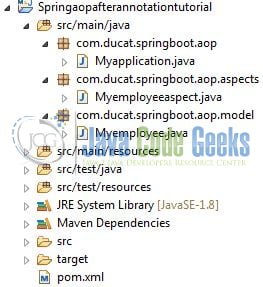
2.3 Project Creation
This section will demonstrate how to create a Java-based Maven project with Eclipse. In Eclipse IDE, go to File -> New -> Maven Project.
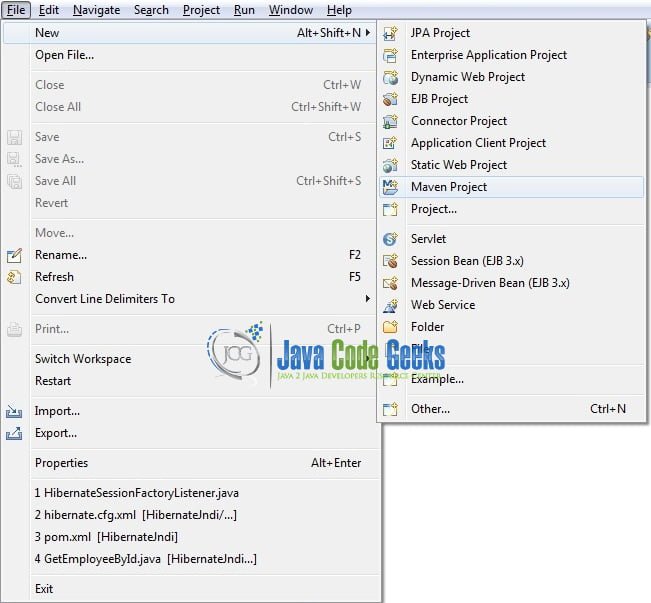
In the New Maven Project window, it will ask you to select a project location. By default, ‘Use default workspace location’ will be selected. Select the ‘Create a simple project (skip archetype selection)’ checkbox and just click on the next button to proceed.
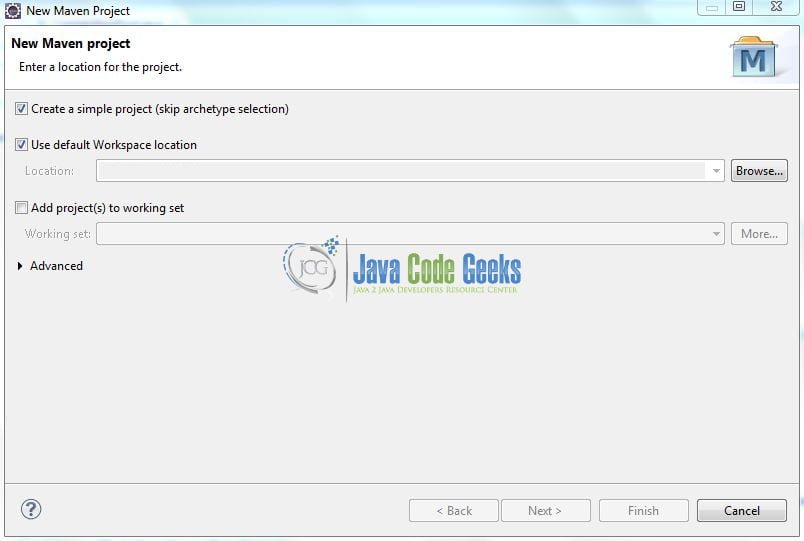
It will ask you to ‘Enter the group and the artifact id for the project’. We will input the details as shown in the below image. The version number will be by default: 0.0.1-SNAPSHOT.
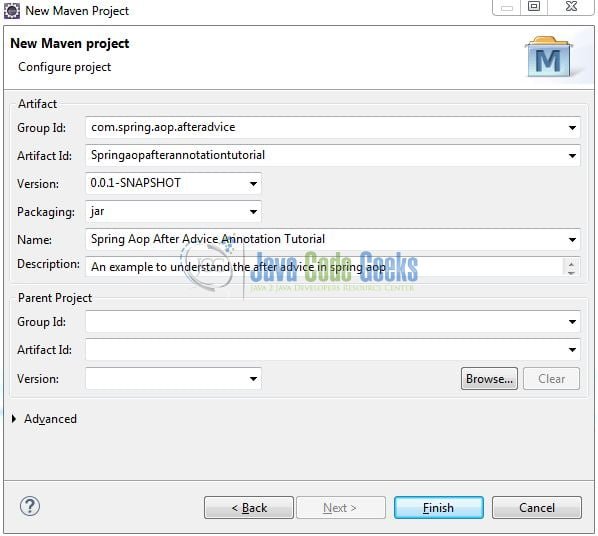
Click on Finish and the creation of a maven project is completed. If you observe, it has downloaded the maven dependencies and a pom.xml file will be created. It will have the following code:
pom.xml
<project xmlns="http://maven.apache.org/POM/4.0.0" xmlns:xsi="http://www.w3.org/2001/XMLSchema-instance" xsi:schemaLocation="http://maven.apache.org/POM/4.0.0 http://maven.apache.org/xsd/maven-4.0.0.xsd"> <modelVersion>4.0.0</modelVersion> <groupId>com.spring.aop.afteradvice</groupId> <artifactId>Springaopafterannotationtutorial</artifactId> <version>0.0.1-SNAPSHOT</version> </project>
We can start adding the dependency that developers want like spring boot, aop etc. Let us start building the application!
3. Creating a Spring Boot application
Below are the steps involved in developing the application.
3.1 Maven Dependency
Here, we specify the dependency for the spring boot and aop. Maven will automatically resolve the other dependencies. The updated file will have the following code.
pom.xml
<project xmlns="http://maven.apache.org/POM/4.0.0" xmlns:xsi="http://www.w3.org/2001/XMLSchema-instance" xsi:schemaLocation="http://maven.apache.org/POM/4.0.0 http://maven.apache.org/xsd/maven-4.0.0.xsd"> <modelVersion>4.0.0</modelVersion> <groupId>com.spring.aop.afteradvice</groupId> <artifactId>Springaopafterannotationtutorial</artifactId> <version>0.0.1-SNAPSHOT</version> <name>Spring Aop After Advice Annotation Tutorial</name> <description>An example to understand the after advice in spring aop</description> <!-- spring boot parent dependency jar. --> <parent> <groupId>org.springframework.boot</groupId> <artifactId>spring-boot-starter-parent</artifactId> <version>2.1.1.RELEASE</version> </parent> <dependencies> <!-- spring boot jar. --> <dependency> <groupId>org.springframework.boot</groupId> <artifactId>spring-boot-starter</artifactId> </dependency> <!-- to implement aop in a spring boot application. --> <dependency> <groupId>org.springframework.boot</groupId> <artifactId>spring-boot-starter-aop</artifactId> </dependency> </dependencies> <build> <finalName>Springaopafterannotationtutorial</finalName> </build> </project>
3.2 Java Classes
Following classes are required to understand the after advice.
3.2.1 Employee Model class
Let us write a model class that has two member variables. This class is annotated with the @Component annotation.
Myemployee.java
package com.ducat.springboot.aop.model;
import org.springframework.stereotype.Component;
@Component
package com.ducat.springboot.aop.model;
import org.springframework.stereotype.Component;
@Component
public class Myemployee {
// Dummy values for an employee!
private int id = 1001;
private String name = "Javacodegeek";
public int getId() {
return id;
}
public void setId(int id) {
this.id = id;
}
public String getName() {
return name;
}
public void setName(String name) {
this.name = name;
}
// Method to display the employee details.
public void display() {
System.out.println("Employee id= " + getId() + ", name= " + getName());
}
}
3.2.2 Employee Aspect class
Let us write the aspect class where we will define a pointcut expression and the @After annotation to meet the cross-cutting concern of our application. This class is annotated with @Aspect and @Component annotations.
Myemployeeaspect.java
package com.ducat.springboot.aop.aspects;
import org.aspectj.lang.JoinPoint;
import org.aspectj.lang.annotation.After;
import org.aspectj.lang.annotation.Aspect;
import org.aspectj.lang.annotation.Pointcut;
import org.springframework.stereotype.Component;
// @Aspect annotation enables the spring aop functionality in an application. Tells the developer that this class has advice methods.
@Aspect
@Component
public class Myemployeeaspect {
// Pointcut definition to display all the available methods i.e. the advice will be called for all the methods.
@Pointcut(value= "execution(* com.ducat.springboot.aop.model.Myemployee.*(..))")
private void displayEmployee() { }
// Method is executed after the method matching with a pointcut expression.
@After(value= "displayEmployee()")
public void afterAdvice(JoinPoint jp){
System.out.println("Inside afterAdvice() method...." + " Inserted after= " + jp.getSignature().getName() + " method");
}
}
3.2.3 Implementation/Main Class
Let us write the implementation/main class involved in this application. This class is the entry point of the spring boot application containing @SpringBootApplication, @EnableAspectJAutoProxy annotations, and the static main method.
Myapplication.java
package com.ducat.springboot.aop;
import org.springframework.boot.SpringApplication;
import org.springframework.boot.autoconfigure.SpringBootApplication;
import org.springframework.context.ConfigurableApplicationContext;
import org.springframework.context.annotation.EnableAspectJAutoProxy;
import com.ducat.springboot.aop.model.Myemployee;
@SpringBootApplication
// @EnableAspectJAutoProxy annotation enables support for handling the components marked with @Aspect annotation. It is similar to <aop:aspectj-autoproxy> tag in the xml configuration.
@EnableAspectJAutoProxy
public class Myapplication {
public static void main(String[] args) {
ConfigurableApplicationContext context = SpringApplication.run(Myapplication.class, args);
// Fetching the employee object from the application context.
Myemployee myemployee = context.getBean(Myemployee.class);
// Displaying employee details.
myemployee.display();
// Closing the context object.
context.close();
}
}
4. Run the Application
To execute the application, right click on the Myapplication.java class, Run As -> Java Application.
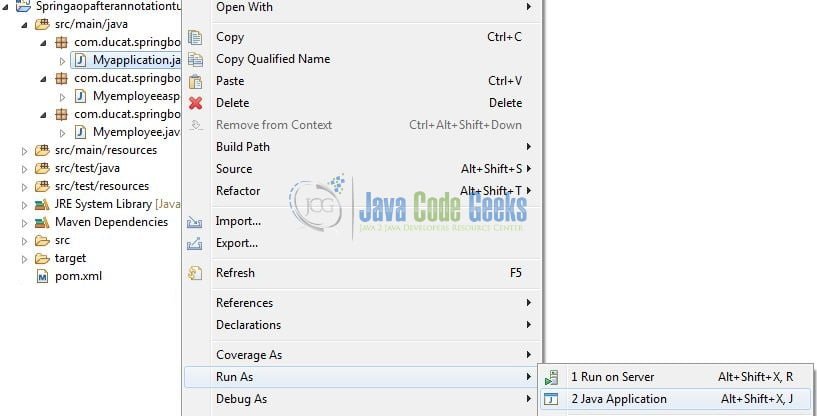
5. Project Demo
The code shows the following logs as the output of this tutorial.
2019-02-13 19:11:28.016 INFO 952 --- [ main] com.ducat.springboot.aop.Myapplication : Started Myapplication in 1.416 seconds (JVM running for 1.922) Employee id= 1001, name= Javacodegeek Inside afterAdvice() method.... Inserted after= display method
That is all for this tutorial and I hope the article served you whatever you were looking for. Happy Learning and do not forget to share!
6. Conclusion
In this section, developers learned how to create a simple spring aop application. That is all for this tutorial and I hope the article served you whatever you were looking for. Happy Learning and do not forget to share!
Developers can download the sample application as an Eclipse project in the Downloads section.
7. Download the Eclipse Project
This was an example of after advice in the spring aop module.
You can download the full source code of this example here: Spring AOP @After Advice Type Example



